Yes, matsutake grow in Minnesota and the Midwest, but they're difficult to find. In this post, and my follow up Hunting the Minnesota Matsutake II, I explain how to find them.
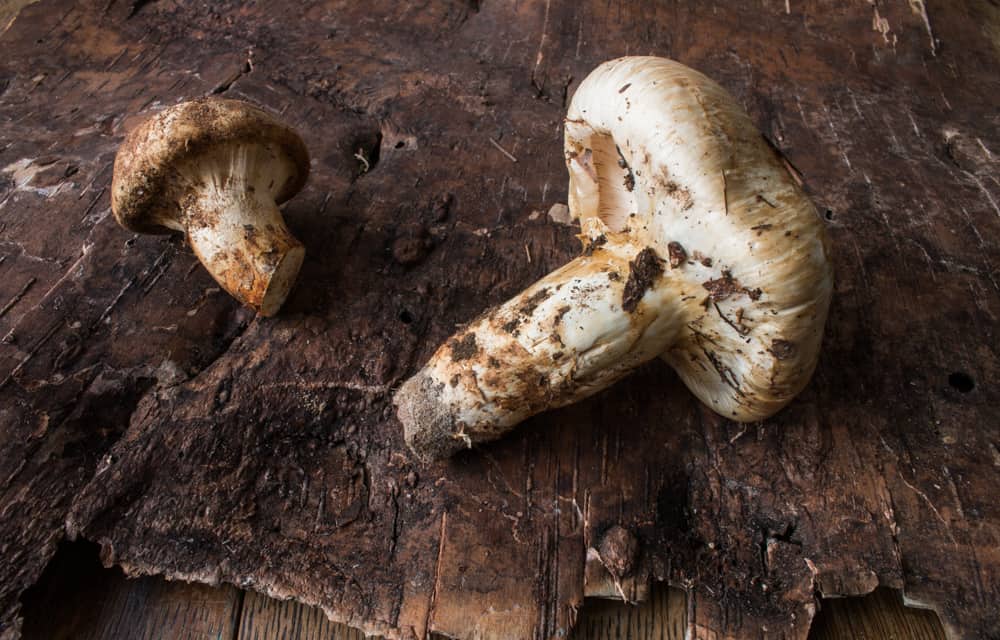
I get a lot of messages about mushrooms, as well as pictures and inquiries, both from regular readers and also from the occasional random person. Most of the time, they're what you would expect: a picture of a nondescript mushroom and a question along the lines of "What is this and can I eat it?"
I do my best to answer every inquiry and provide additional information when I can. The way I see it, both helping beginners and sharing insights with experienced hunters is part of my job.
That being said, most of the photo inquiries people send me can be answered quickly with a few canned responses.
Don't eat that, it's poisonous.
Don't eat that, it's rotten and decayed.
Don't eat that, I don't know what it is.
Don't eat that, but send me your GPS location.
Okay, the last one is a joke, but you get the picture.
In the fall of 2015, I got a message that was out of the ordinary, something to the tune of "Hi Chef! I live in Wisconsin and found some Matsutake. You should come pick some with me next year!"
I struggled to find a combination of expletives to convey my excitement.
Quick history for newbees:
If you don't know your hierarchy of prized wild mushrooms, matsutake (Matsies for short) are basically the national mushroom of Japan and the most expensive mushroom in the world (since truffles are not technically a mushroom).
In Japan, they're collected in the fall, but harvests there have begun to dwindle in recent history, and now matsutake are harvested and imported from a number of different places, notably South Korea and the American Pacific Northwest (which is where the first matsutake I ever cooked came from).
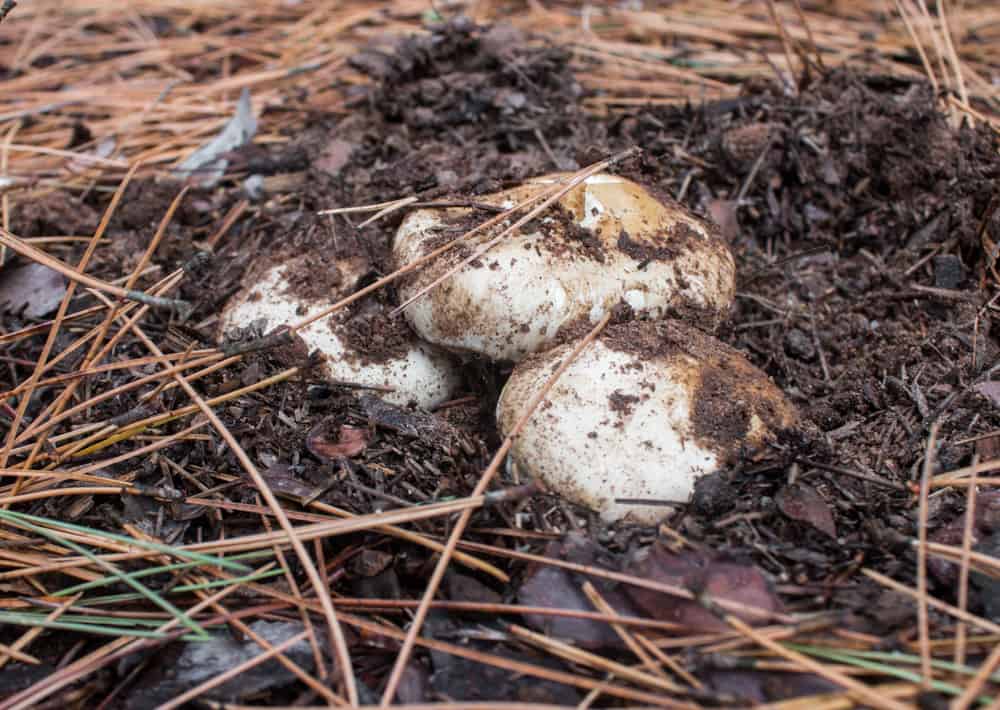
If you haven't had the pleasure of eating a matsutake, their aroma is what their prized for — a weird cinnamon-spicy-cedar combo that's hard to describe. You won't forget it, but you'll have difficulty explaining it, too. Young mushrooms picked before the veil that covers the gills breaks open are the most prized, and typically have the strongest flavor.
The news of matsutake spread quickly since they were first found in America, and there's been plenty of talk about them. For more reading on matsutake, here's a great article from the New Yorker. You might also want to check out this book, The Mushroom Hunters by Langdon Cook, which discusses both the hunters and nomadic/migrant culture that mushrooms support.
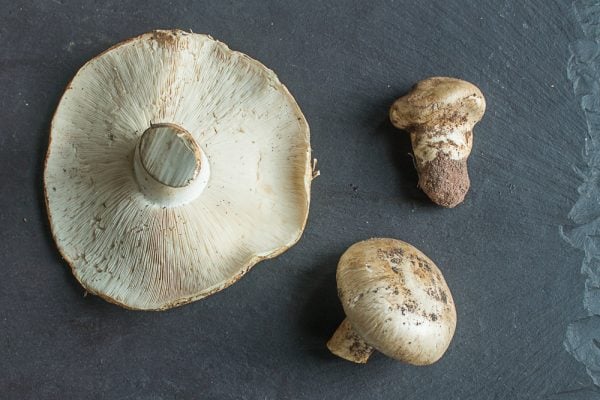
The reason I found my first invitation to harvest matsutake so exciting was that, while I own plenty of mushroom guides for the Midwest, not a single one mentions matsutake growing in Minnesota or the Midwest in general.
The only references I could find online were to of a cousin of the matsutake, Tricholoma caligatum (as well as a very funny account, from mushroom author Micheal Kuo, of his hunting them).
Tricholoma caligatum is known to grow under oaks in Minnesota, but is apparently not as good as the real-deal matsutake, which only grow under conifers.
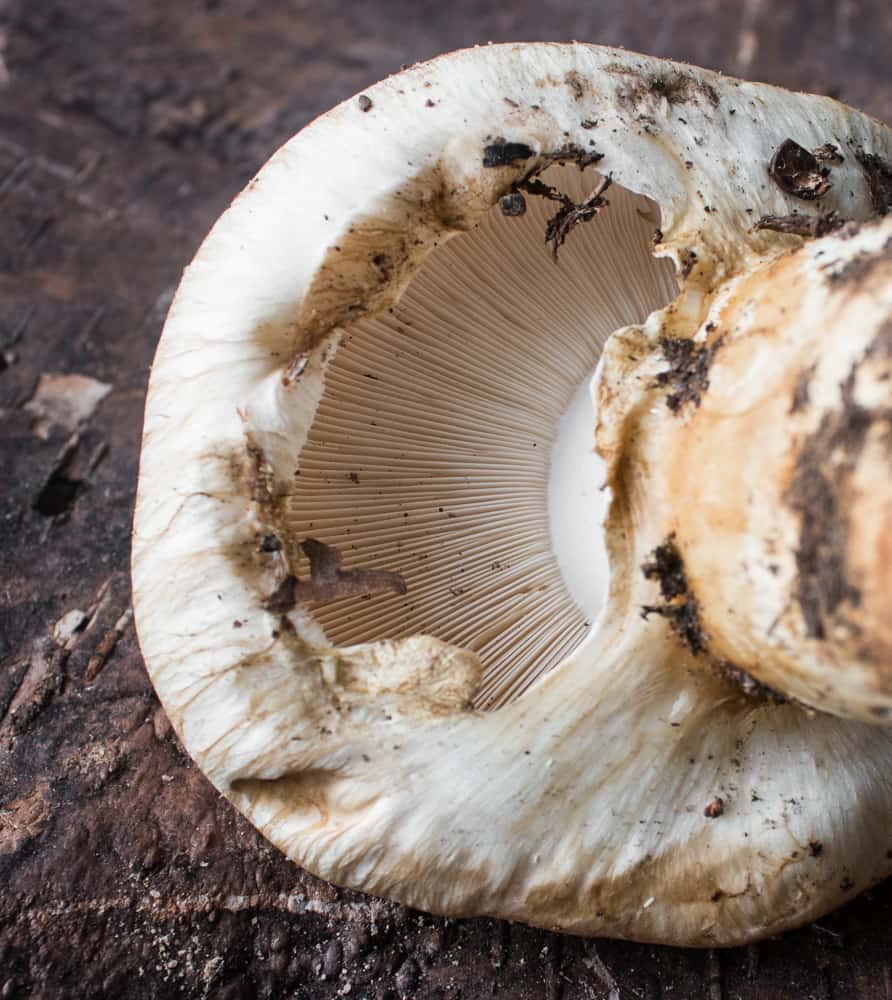
Back to the hunt. As excited as I was to get the invitation, I bided my time for an entire year because it was late in the picking season. Then I got insanely busy with my job, and basically forgot all about the matsutake. Maybe on some level, I just didn't believe they existed — that the invitation to come pick them was more likely a ruse designed by a prankster just to mess with me.
Then, late summer 2016, a local mushroom purveyor announced they'd picked a few matsutake in Minnesota. I knew people had looked for them in the Midwest, but I didn't know of anyone that had actually picked one. My experienced mushroom-hunting friends from the Minnesota Mycological Society talked about them like a grail, something a few hunters had searched for, but that none had found.
But now, the hunt was on, a giant needle in a haystack the size of Minnesota and Wisconsin. By this time, I was between jobs, so I took a couple days to just hunt all by myself, do some research on the terrain I needed to be in, and find areas that seem to fit the bill.
Again and again, I walked through stands of pine, and eventually fell to distracting myself from my failed matsutake quests by picking fall consolation mushrooms. "I'll try again next year," I thought.
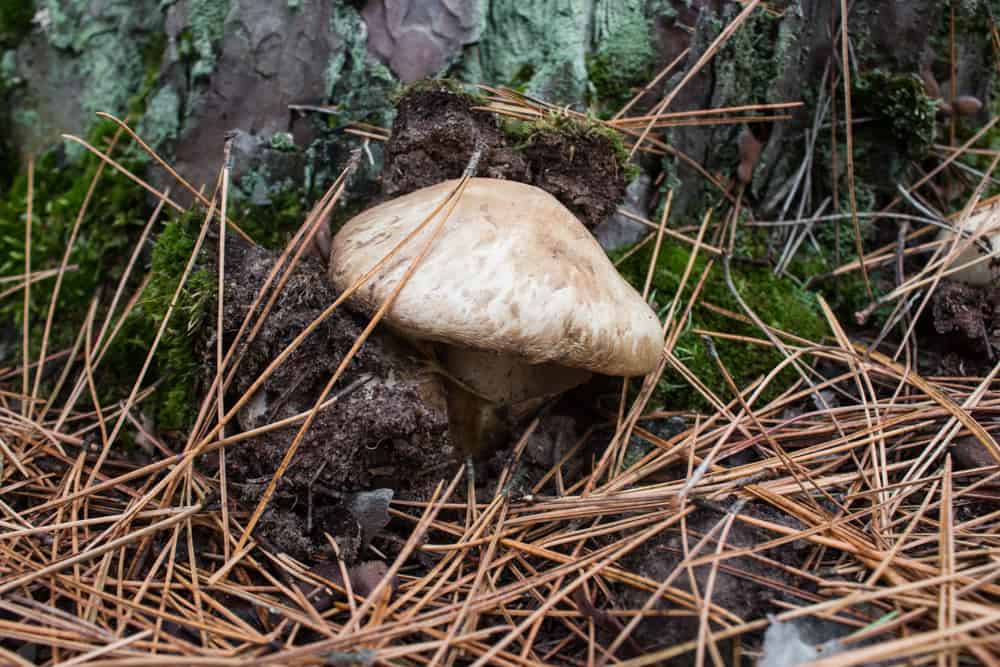
But then, as luck would have it, my mystery matsutake messenger got back in touch with me, and on October 12th we made it out to her patch-a big stand of red pine.
Until I dug one out of the ground and smelled it for myself, I was skeptical and didn't really believe it. I thought it had to be a lesser version of them, or somehow flawed.
Sure enough, though, it was them, and they were just as good as I remembered the last time I tasted some shipped from the Pacific North West — better, even.
Which exact species of matsutake they were, I don't know, but their signature aroma was very strong, even as they matured and broke their veil.
After re-reading literature I have at home, I found some good info from Michael Kuo that made me wonder even more about their true identity and origins.
Here's an excerpt from his Kuo's writing on the topic of matsutake mushrooms in America:
DNA studies have shown not only that specimens from the northeast are distinct from western and Mexican specimens, but that northeastern matsutakes are aligned with specimens from Asia and Europe identified as Tricholoma matsutake (the "true" matsutake of Asia) and Tricholoma nauseosum (the European matsutake).
If that's true, then there's the possibility that our Midwest matsutake here are more closely related to the "true" Japanese species than the Pacific Northwest Species.
At the end of the day though, whatever particular species they are doesn't really matter to me. They're matsutake from the Midwest: Bucket-list, check!
Want to find some matsutake of your own? Here are a few points I've gathered about hunting them in the Midwest:
Midwest Matsutake Hunting Tips
From what I've gathered so far:
- Growing with red pine or jack pine, in conifer-dominated forests
- Season: roughly August through October
- Look for "mushrumps," little lumps indicating they're hiding under the needles
- In the patch we were picking, Lactarius mushrooms were growing all around the area too, mainly saffron milkcaps and L. detterimus.
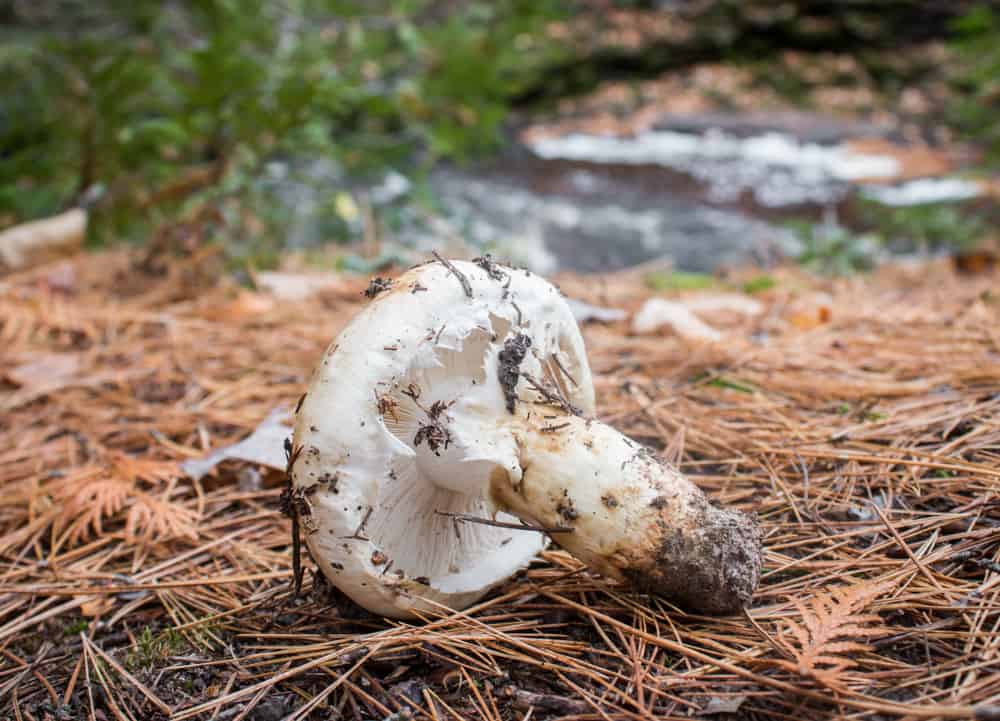

John ullman
Thank you so much for this article. My grandson just left Seattle to go to college at Carlton in Northfield, MN. I felt so sorry for him having to miss matsutake season in the Northwest. So, imagine my joy at finding he can still hunt Matsutake. He is a fourth generation Matsutake hunter. My wife learned from her mother, who was Japanese. We taught our children and grandchildren how to find them. It is one of our most important family traditions, second only to the several ways we cook them.
Alan Bergo
Thanks John that makes my day.
Chris L.
Chef Alan I have an inquiry about my first 3 finds here in MB, Canada. The Matsies I found are mature, but still possess their distinctive aroma. But the one my boy found has obvious veil remaining on stem & the gills under cap are white. I really want to cook this into that ramen recipe. --> Can I stock the two older ones, discard them later & use the better Matsie chopped up adding it to the soup?
Thank you.
Alan Bergo
HI Chris. Yes you can use the older ones for stock. I also clean them, pull apart into pieces and freeze wrapped in aluminum foil, putting the aluminum foil into zip loc bags and freezing. They keep very well like that in the freezer.
Gilbert
They grow along the highway into Yellowknife, NWT, in jackpine. That climate is not much different from here, Cook County, Lake Superior, a few miles back and 1000 feet above the lake. I am looking. Red pine and jackpine? When? Late summer?
Dr Dave
There is one location in Wisconsin I know that often has matsutake. The WMS has a foray there, and I often return 2-4 weeks later than the scheduled foray. Today. 10/23/2019, I picked two young matsutake with closed intact veils, each weighing 8-12 ounces. In the past, I have found up to 5 pounds at the scheduled foray. Abundance and timing is variable from year to year. Here, they typically grow in swampy areas with older hemlocks from the large needle duff mounds accumulated over many years.
A friend in the WMS reports picking huge quantities on his friend's property in Canada.. I once had a small taste of PNW matsutake at a NAMA annual foray at Whistler, BC, and I think our local Wisconsin matsutake are at least as good as those from the PNW.
Richard
My grandpa and I stumbled across these mushrooms wondered if you could help us identify. We would need some help finding out.
Alan Bergo
Join a Facebook group, a mycological society, or buy some guides. If I just tell you what they are you’ll never learn to tell bad from good. Alan.
Richard
My grandpa and I stumbled across these mushrooms wondered if you could help us identify.
Glenn Freeman
THE Matsutake expert here in Michigan is Ken Harris of Michigan Mushroom Market.
I joined him this past October in Northern Michigan after informing me nearly no restaurants wanted to buy them so he was not planning to pick them commercially this year. So I made a trip and he showed me the types of locations they grow and how to spot them ... we picked pounds and pounds.
In addition to the Lactarius you mention there were lots of late Black Trumpets and Chanterelles nearby as well ... a rough timeline for when to best look for them in Michigan.
They are my favorite mushroom, by far.
Nathan Perrier
Hey Alan, this book about the Matsutake might interest you. Just pre-ordered on Amazon:
https://www.amazon.com/gp/product/0691178321
Also just finished reading The Mushroom Hunter. Loved it!!!
John Smalldridge
Red pines, just like the Japanese matsu. You lucky dog! I'm envious.
Lawrence
Hi Alan,
I'm so excited to hear of some possibility of stumbling upon this amazing mushroom. I used to live in Northern Wisconsin and found a bunch between Washburn and Cornucopia in the "barrens". Super sandy soil up there and lots of coniferous trees...especially jackpines. I recall an old field guide that had information about them from the 60's. I think it might have been by Alexander Smith (University of Michigan), but I'm not certain. I'll look at my collection of old field guides and see if I can find any further insight.
Thanks for the posts. Keep up the great work. I'll try and head over to Lucia's some day soon to check out what you are up to, as I'm only a few blocks from there.
Happy new year!
Alan Bergo
Thanks Lawrence, there's more patches out there. I'm excited to check out more territory next year.
Joe Wiercinski
Hi, Alan,
Maybe you already know about Dr. Tom Volk, a mycologist at University of Wisconsin-La Crosse. He and Gary Lincoff both rocked a September foray with Western Pennsylvania Mushroom Club about a dozen years ago. Lincoff used to lead the popular hunt every year outside Pittsburgh. I wrote a local newspaper feature about that fine day.
In the link below, Volk almost certainly is describing the woodland wonder that currently has fired your interest. Mine, too, after reading your post.
http://botit.botany.wisc.edu/toms_fungi/sep2000.html
Cheers,
Joe Wiercinski
Ken Marsden
After sun drying mushrooms what is the best way to store them, freeze, airtight container, oil, ????
Alan Bergo
I store mine in airtight containers, out of the light, ziplocks work.
Judy J
What would you say the range is in MN and WI? I wouldn't think western MN but how about SE MN or the arrowhead? More red and jack pine are found in northern MN and there are some large stands of pines in some of the state parks in the middle of WI. If I try to look for them next year, I want to make sure there is at least a possibility of finding them. Thanks
Alan Bergo
My advice=go north. I'm speculating but I would say they like the Taiga landscape of North MN and WI. I wouldn't go to SE MN, personal opinion.
Nicole Novak
Hi Alan,
In our area of Northern California nearest to San Francisco, our matsutake grow in mixed woods and are primarily associated with tanoak and huckleberry. They are quite prolific in good years and their season can be short or long depending on precipitation and temperatures. I have no idea if they are a different species from those that grow in the conifers further north of our "territory".
Dan F
I'm dumbstruck!!!
Alan Bergo
I didn't believe it until I smelled them.
A. J Dixon
Hello Chef!
My name is AJ Dixon,
I am wonder and head chef of Lazy Susan MKE in Milwaukee, WI. I love your posts. I am also a foraging chef.
I am an honorary member of the Wisconsin Mycological Society. I always do a yearly mushroom dinner with them, and I am in the works of setting a February date. I was wondering if you had time to come and cook and share some of your stories or food with them. They are a great group and it is a great time.
I am planning on a Sunday Or Monday in Feb, after Valentine's Day. Given that it is winter, most Mushrooms would be from a local importer/grower Mushroom Mike, as well as River Valley and Sugar Bee Farms.
Hope to hear from you soon.
AJ
Alan Bergo
Hi AJ. Shoot me a message to my email and we can discuss. alanbergo3@gmail.com
DAVE Minarich
Hi Alan,
I too believe I found Matsutake mushrooms in northern MN. Last fall.
But wasn't sure so took a pic and left them...
How can I send you the picture?
Alan Bergo
send it to my email, I'm happy to give you my opinion. I'm getting more reports here and there of them being ID'd locally last year, but the bragging rights they come with are no less impressive! Send your shots to: alanbergo3@gmail.com